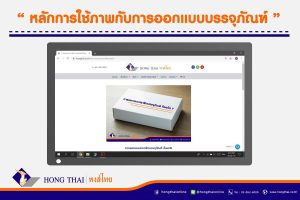For SME business owners, success factors include making their brand and products known or accepted by consumers. Simply producing high-quality products may not fully meet the demands. In the current situation, both government and private sectors have been promoting the use of eco-friendly food and beverage packaging, encouraging the public to prioritize sustainable packaging options.
Choosing Eco-Friendly Packaging for Businesses
Eco-friendly packaging options chosen by many business owners or provided by packaging manufacturers, from design through to material selection and production, often involve paperboard packaging. It’s important for business owners to study the types of paperboard packaging available today to choose the most appropriate for their products. These options include:
1. Foldable Paperboard Boxes: These boxes are designed for easy assembly. They come in flat sheets, and when needed, adhesive can be applied along the box edges to assemble and seal the box. This type comes in two styles: tray boxes and tube boxes.
2. Pre-formed Paperboard Boxes: These are fully formed, such as shoe boxes with a lid. Their advantage lies in their durability and long-lasting use. A distinctive design can add value to the product and attract consumer attention, though the cost is higher than that of foldable boxes.
3. Cardboard Packaging: This consists of a combination of paper and plastic sheets, which can be either pre-formed or unformed. The product sits between these two materials.
4. Multi-layer Coated Paperboard Packaging: This is widely used for food and beverage packaging.
5. Corrugated Paperboard Boxes: These are strong, protective packaging options that safeguard the product. They also raise consumer awareness about eco-friendly packaging.
Consumer Awareness of Eco-Friendly Packaging
As a result of environmental campaigns led by both government and private organizations, consumer purchasing behavior has shifted, with examples including:
1. Health consciousness, shown by the preference for ready-to-eat foods or meals in packaging that meets high standards for cleanliness and safety.
2. Choosing consumer goods certified with green labels or energy-saving labels like the 5-star energy label.
3. Opting for packaging like biodegradable food boxes or containers made from paper that decompose naturally.
Consumer awareness about packaging waste and improper disposal leading to pollution has also encouraged more businesses to focus on eco-friendly packaging. Choosing products in paperboard, glass, or microwave-safe food boxes that can naturally decompose is motivating business owners to prioritize sustainable packaging options for their products.






